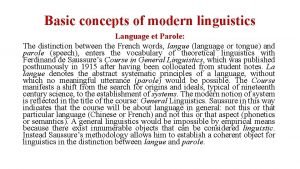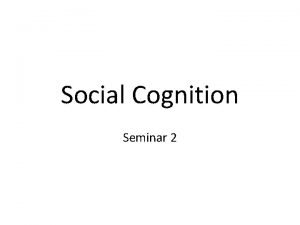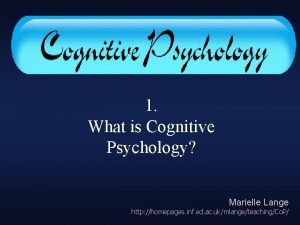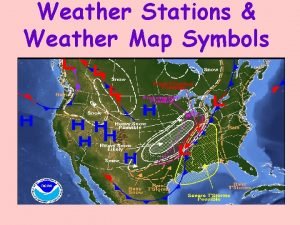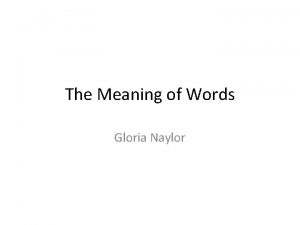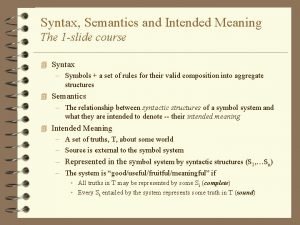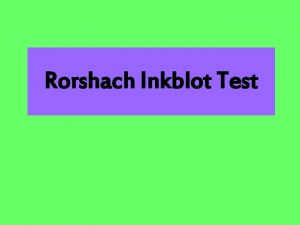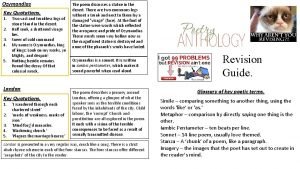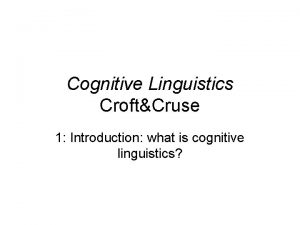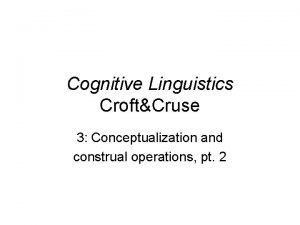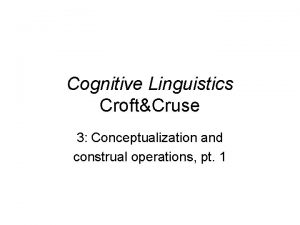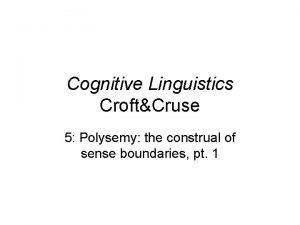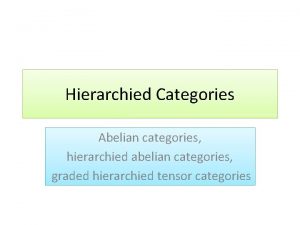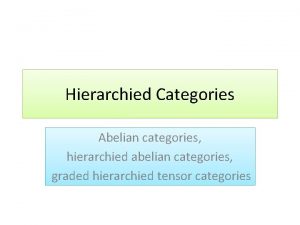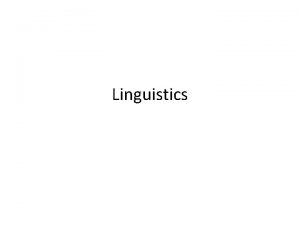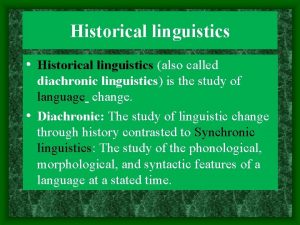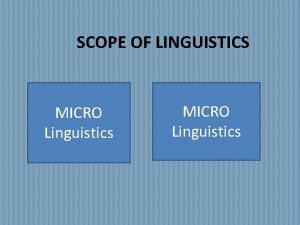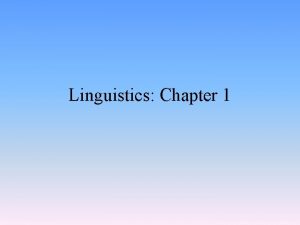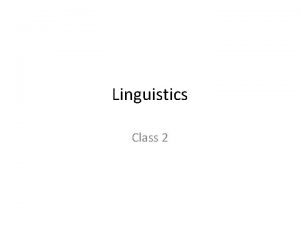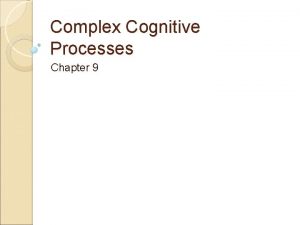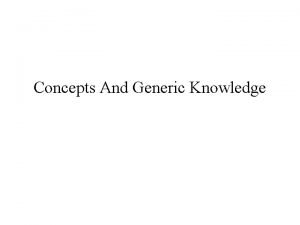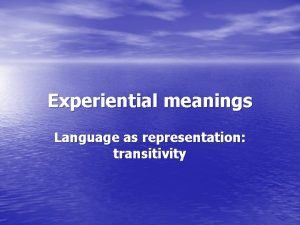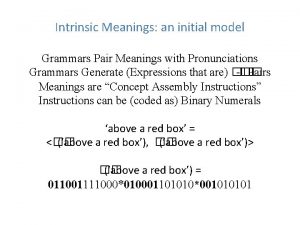Cognitive Linguistics CroftCruse 4 Categories concepts and meanings




















- Slides: 20

Cognitive Linguistics Croft&Cruse 4: Categories, concepts, and meanings, pt. 1

4. 1 Introduction • Functions of conceptual categories: – Facilitate learning over nonidentical events – Planning requires generalization across individuals – Communication cannot contain all detail – Economy of knowledge storage and retrieval

4. 1 Introduction • Ways to look at categories: – As collections of entities, with central prototypes and peripheral members – How the members of one category differ from those of another category – Level of categorization

4. 2 The classical model of category structure • Classical categories – are defined by necessary and sufficient features – have clear, rigid boundaries – have no internal structure

4. 2 The classical model of category structure • Q: What are the problems with classical categories?

4. 2 The classical model of category structure • Q: What are the problems with classical categories? • A: – many everyday concepts cannot be defined in terms of necessary and sufficient features – category membership is often scalar, not absolute – the boundaries of categories are often “fuzzy”

4. 3 The prototype model of category structure • There is an alternative to the classical model that avoids its drawbacks….

4. 3. 1 Graded centrality • It is easy for people to rate the GOE (goodness-of-example) of certain items in relation to a category, and this correlates with frequency, order of mention/learning, family resemblance, verification speed, and priming top-scorer for VEGETABLE low-scorer for VEGETABLE

4. 3. 2 The representation of conceptual categories • There are two ways to look at categories: – As a list of properties/features, which are not necessary or sufficient, but which characterize the prototype, which is an idealization of the category – As an organization in terms of similarity to an idealized member [These are very similar approaches and do not have to be distinguished. ]

4. 3. 3 Levels of categorization • The basic level category has properties more salient than either the superordinate or subordinate levels…

4. 3. 3. 1 Basic level categories • Q: What is special about basic level categories (car, apple, dog, knife, table)?

4. 3. 3. 1 Basic level categories • Q: What is special about basic level categories (car, apple, dog, knife, table)? • A: – Most inclusive level with characteristic patterns of behavioral interaction, for which a clear visual image can be formed, at which part-whole information is represented – Level used for everyday neutral reference – Level most rapidly accessed in categorization


4. 3. 3. 2 Superordinate level categories • Q: What do we know about superordinate level categories (vehicle, fruit, furniture)?

4. 3. 3. 2 Superordinate level categories • Q: What do we know about superordinate level categories (vehicle, fruit, furniture)? • A: – within-category resemblance is relatively low – fewer defining attributes – one attribute tends to connect basic-level to superordinate-level categories – superordinate categories are often named with mass nouns and tend to be morphologically complex, whereas basic-level categories are named with count nouns that are morphologically simpler

4. 3. 3. 3 Subordinate level categories • Q: What do we know about subordinate level categories (hatchback, Granny Smith, card table)?

4. 3. 3. 3 Subordinate level categories • Q: What do we know about subordinate level categories (hatchback, Granny Smith, card table)? • A: – less distinct from neighboring categories – not more informative than basic-level – frequently morphologically complex


4. 3. 4 Shortcomings of prototype theory • Simplistic nature of feature list – cannot account for interaction of factors • Odd number paradox – people will score GOE even if there is a necc&suff criterion (1, 3, 5 are “better examples” of odd number than 135 or 10, 975…) • Where do features come from? • Why are some categories mutually exclusive? • Boundaries – where are they and how do they behave?

4. 3. 5 The frame-based account of prototype effects • Frames, ICMs can guide us toward a better understanding of the structure of cognitive categories.
 Language
Language Linguistics vs applied linguistics
Linguistics vs applied linguistics Generative linguistics and cognitive psychology
Generative linguistics and cognitive psychology Cognitive and non cognitive religious language
Cognitive and non cognitive religious language Parole vs langue
Parole vs langue Artificial language
Artificial language Cognitive psychology concepts
Cognitive psychology concepts 5 major domains of psychology
5 major domains of psychology Examples of theological virtues
Examples of theological virtues Weather map symbol
Weather map symbol The meanings of a word naylor questions and answers
The meanings of a word naylor questions and answers Syntax symbols and meanings
Syntax symbols and meanings What are literary symbols
What are literary symbols Statistical symbols and meanings
Statistical symbols and meanings All traffic signs and meanings
All traffic signs and meanings Types of sacred vessels
Types of sacred vessels Wise in kinyarwanda
Wise in kinyarwanda Rorschach test definition psychology
Rorschach test definition psychology Rastafarian origins
Rastafarian origins Symbol of pnp
Symbol of pnp Ozymandias explanation with quotations
Ozymandias explanation with quotations




